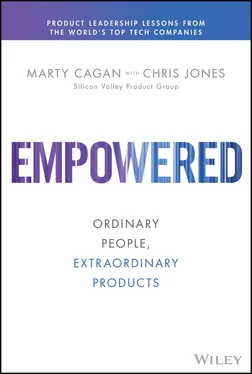But here's the problem: the CIO truly is there to serve the business .
The very traits that make for a strong CIO can easily end up undermining the company's attempts to transform.
That's my theory for why I've found it very difficult to get CIOs—even strong CIOs—to appreciate, much less adopt, the mindset, methods, and practices of product engineering organizations.
What's especially problematic is that product engineers—the type the future of your company depends on—are rarely willing to work for a CIO because they know this difference in mindset is extremely important.
Engineers in a CIO's organization play a very different role than engineers in a CTO's organization. It's the difference between feature teams and empowered product teams.
In some cases, I've encouraged the CIO to retitle as CTO (because I believed the person was up to the challenges of this much larger role), and in other cases I've strongly encouraged the CEO to hire a true CTO to lead product engineering.
1 1 https://a16z.com/2011/08/20/why-software-is-eating-the-world/.
2 2 https://www.bloomberg.com/news/articles/2019-06-28/boeing-s-737-max-software-outsourced-to-9-an-hour-engineers.
3 3 Bob Lutz, Car Guys vs. Bean Counters: The Battle for the Soul of American Business (New York: Portfolio/Penguin, 2013).
CHAPTER 3
Strong Product Leadership
The heart of this book is the importance of strong product leadership.
To be clear, by “product leadership” I mean the leaders and managers of product management, the leaders and managers of product design, 1 and the leaders and managers of engineering.
For this discussion, I will distinguish between leaders and managers. Certainly, many leaders are also managers, and many managers are also leaders, but even if both roles are covered by the same person, there are different responsibilities.
Overall, we look to leadership for inspiration and we look to management for execution.
The Role of Leadership—Inspiration
The subject of strong leadership, is of course, a major topic, but it is a clear and visible difference between strong product companies and most companies.
The purpose of strong leadership is to inspire and motivate the organization.
If product teams are to be empowered to make good decisions, they need to have the strategic context necessary to make those decisions.
Part of the strategic context comes from the senior leaders of the company, such as the purpose of the business (the mission) and critical business objectives, but the product leadership has four major explicit responsibilities:
Product Vision and Principles
The product vision describes the future we are trying to create and, most important, how it improves the lives of our customers.
It is usually between 3 and 10 years out. The product vision serves as the shared goal for the product organization.
There may be any number of cross‐functional, empowered product teams—ranging from a few in a startup, to hundreds in a large enterprise—but they all need to head in the same direction and contribute in their own way to solving the larger problem.
Some companies refer to the product vision as their “North Star”—in the sense that no matter what product team you're on, and whatever specific problem you're trying to solve, you can all see and follow the North Star. You always know how your piece contributes to the more meaningful whole.
More generally, the product vision is what keeps us inspired and excited to come to work each day—month after month, year after year.
It is worth noting that the product vision is typically the single most powerful recruiting tool for strong product people.
Product principles complement the product vision by speaking to the nature of the products that your organization believes it needs to produce. The principles reflect the values of the organization, and also some strategic decisions that help the teams make the right decisions when faced with difficult trade‐offs.
The “team topology” refers to how we break up the work among different product teams to best enable them to do great work. This includes the structure and scope of teams, and their relationship to one another.
The product strategy describes how we plan to accomplish the product vision, while meeting the needs of the business as we go. The strategy derives from focus , then leverages insights , converts these insights into action , and finally manages the work through to completion.
Another critical role of leaders is communicating the product vision, principles, and product strategy—both to the internal product organization, and also across the company more broadly.
John Doerr, the famous venture capitalist, likes to explain that “We need teams of missionaries, not teams of mercenaries.”
If we want teams of missionaries, it's essential that every person in the organization understands and is convinced—they need to be true believers .
This requires an ongoing crusade of evangelizing—in recruiting, onboarding, weekly 1:1 coaching, all‐hands meetings, team lunches, and everything in between.
The larger the organization, the more essential it is to be very good at evangelism, and it's important for the leaders to understand that evangelism is something that is never “done.” It needs to be a constant.
We want to ensure that every member of the product organization has joined because they sincerely believe in the larger purpose.
Normally, it is the product vision that describes what people are signing up for, but one way or another, we need to ensure the people on the team are true believers.
For example, if your vision is to deliver mass‐market electric cars, then we need people that are willing to take the leap of faith that this is both possible and worthy. Note that it is not a problem if the person you hire has different views on what might work to get us to mass‐market electric cars, but it is not helpful, for example, to hire a passionate advocate for internal combustion engines.
The Role of Management—Execution
There are of course many types of “managers” in a company. I'm most interested here in those people responsible for hiring and developing the actual members of the cross‐functional product teams.
Normally, this includes the director of product management, the director of product design, and the managers and directors of engineering. I'm not focused here on more senior‐level managers (managers of managers), or non‐people managers (such as product managers or product marketing managers).
If you want to have truly empowered product teams, then your success depends very directly on these first‐level people managers .
If you are wondering why there are so many weak product companies in the world, this would be the primary culprit. And until and unless this is corrected, there's little hope for transformation.
It is important that these managers understand—and can effectively communicate—the product vision, principles, and product strategy from the senior leaders. Beyond that, these managers have three critically important responsibilities:
These are the people we hold responsible for staffing the product teams. This means sourcing, recruiting, interviewing, onboarding, evaluating, promoting, and when necessary, replacing the members of the teams.
Читать дальше











